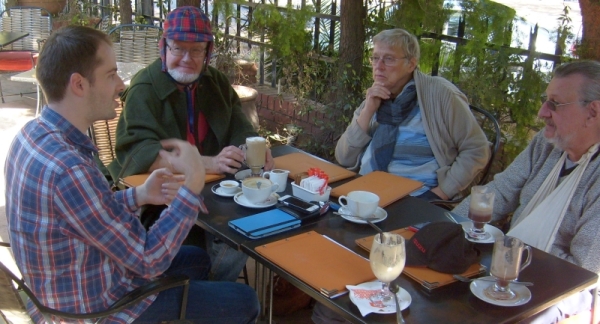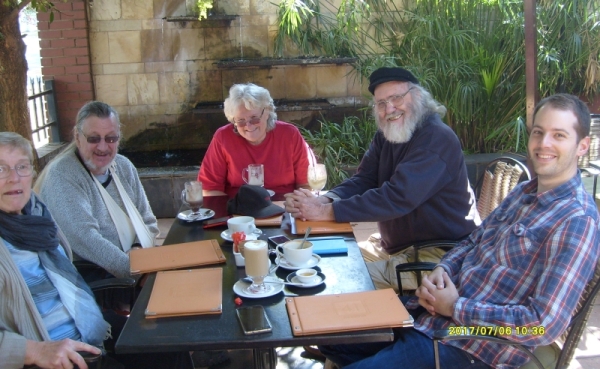The author of this blog has, as her oldest internet friend - even before blogs, Steve Hayes who lives in South Africa. Steve's blog is Khanya. The post below was published on his blog on 7 July 2017. It is republished here with Steve's permission for which I am grateful. For some people, this might be an unusual or distasteful topic. However, without serious consideration and knowledge of this topic, we will be hindered in understanding a large slice of humanity. In fact, when the author of this blog was doing her degree in religious studies, we started off with the James Frazer's The Golden Bough. The Ballarat Library holds the complete set of The Golden Bough - and it is not tucked away in storage but right there on the shelves. ~~~~~~
Witchcraft in literature and life (coffee klatsch)
7 JULY 2017
At our literary coffee klatsch this morning we discussed witchcraft in literature and life, but we didn’t nearly exhaust the subject, so we decided to to continue the discussion next time.
The reason for discussing it was that Duncan Reyburn had published a contribution in a book on witchcraft and demonology, but the book cost far more than most of us could afford, so we asked him to tell us a bit about it and his approach to the subject. I was also struck by the difference between his bibliography and mine in an article on witchcraft 20 years earlier. I dealt with all this in an earlier article, so I won’t repeat it here.

NeoInklings Literary Coffee Klatsch: Duncan Reyburn, David Levey, Janneke Weidema, Tony McGregor.
Cafe 41, Arcadia, Tshwane
Cafe 41, Arcadia, Tshwane
Duncan’s contribution to the books was about how King James was a being really nasty when he wrote his book Daemonologie in 1597. He interprets it in the light the work of René Girard (1923-2015) and especially Girard’s concept of mimetic desire.
If people imitate each other’s desires, they may wind up desiring the very same things; and if they desire the same things, they may easily become rivals, as they reach for the same objects. Girard usually distinguishes ‘imitation’ from ‘mimesis’. The former is usually understood as the positive aspect of reproducing someone else’s behavior, whereas the latter usually implies the negative aspect of rivalry. It should also be mentioned that because the former usually is understood to refer to mimicry, Girard proposes the latter term to refer to the deeper, instinctive response that humans have to each other.
Duncan said that just as King James believed that witches wanted him dead, so he wanted them dead, and vice versa. King James recommended the persecution of witches because he believed that witches were conspiring against him. King James also did not have any clear conception of demons. He believed that witches were inspired by Satan, and there was no hierarchy (or “lowerarchy”, as C.S. Lewis calls it) of evil. There was just Satan and the witches, with no demons in between.
Janneke said that this recalled the Calvinism of her youth, which flattened the hierarchy of the church, so that there were just elders and people. She said this was correlated with literacy — as more people learned to read, they became less reliant on a clerical class.
I recalled reading a book by John Buchan (an imperialist and member of Milner’s Kindergarten) called Witch Wood. I read it a long time ago, and have not seen a copy since, but as I recall it, the good Calvinists went to church by day and practised witchcraft by night, but saw no conflict, because they were among the elect, predestined to be saved, so nothing they did could affect that. I suspect that Buchan’s understanding of the matter was about as accurate as his picture of African Independent Churches in another novel, Prester John, which was, however, probably accurate in the picture it gives of the views of such churches by British civil servants in the conquered Transvaal Colony.

Janneke Weidema, Tony McGregor, Val Hayes, Steve Hayes, Duncan Reyburn — literary coffee klatsch, 6 July 2017
King James wrote his Daemonologie in 1597, at the height of the Great European Witchhunt. People whose minds are saturated with modernity like to refer to those witchhunts as “medieval”, but they were not, they were modern, and arose in the Early Modern period. It is interesting that in the current period, when much of Africa is in transition from premodernity to modernity, there has also been an increase in witchhunting.
Charles Williams, one of the original Inklings, wrote Witchcraft, a history of Christian responses to witchcraft, and noted how the attitude to witchcraft completely changed in the early modern period. Previously it was considered heretical for Christians to believe that witches could harm people, because it showed a lack of faith in Christ, who had conquered evil. In Early Modern Europe, however, it became heretical not to believe that witches could harm people. Earlier, people who made false accusations of witchcraft could be punished, but in Early Modern Europe failure to accuse could be interpreted as a sign of being a witch. Witchcraft came to be seen as a huge satanic conspiracy against church and state. As Charles Williams puts it:
The Salic law of Charlemagne decreed that anyone who was convicted of witch-cannibalism should be heavily fined, but also that anyone who was found guilty of bringing such an accusation falsely should be fined an amount equal to one third of the other… The secular governments of centuries earlier had been wiser; they had penalized the talk as much as the act. The new effort did not do so; it encouraged the talk against the act.
Christianity came into a world in which witchcraft was already known and feared as evil. For many pagans, the only proper penalty for witchcraft was death. Again, as Charles Williams put it:
Before Christendom began, magic, with its lower accompaniment of witchcraft, preoccupied the whole Roman Empire; we have forgotten the darkness out of which we came. It was as popular as it was perilous. It was certainly regarded by the authorities as a public danger, but, on the whole, action against it was taken only by private persons in lawsuits or by the government in suspicion of treason.
In much of premodern Africa, witches were regarded as incorrigible, and the only way of nullifying their power was to kill them. Nearly all evil, sickness, accidents and other misfortunes, were regarded as being caused by human malice — witchcraft. There were spiritual or religious specialists who could smell out who was responsible for a particular misfortune, and the English translated most of the words for these specialists as “witchdoctors” — doctors who could remedy the evils caused by witchcraft.
Christian missionaries from late modern Europe and North America could not cope with premodern notions of witchcraft, and so saw their mission as modernising Africans (they called it “civilising”) to show them that such notions were false and out of date. It was African independent church groups like the Zionists who recontextualised the Christian gospel back into premodern terms to show how it could deal with African problems rather than modern European ones.
We briefly discussed the way in which, in English usage, “witch” has come to be seen as mostly female, while the male equivalent are called “wizards”, as in the Harry Potter stories. Perhaps we can talk about that more next month. Some did a bit of Googling on cell phones, but I think the following is more helpful:
What really is a witch? One answer lies in the roots and development of words. ‘Witch’ derives from the Old English wicca (pronounced ‘witcha’ and meaning male witch) and wicce (‘female witch’, pronounced ‘witcheh’) and from the word wiccian, meaning ‘to cast a spell’. Contrary to common belief among modern witches, it is not Celtic in derivation, and it has nothing to do with the Old English witan, ‘to know’, or any other word relating to wisdom. The explanation that witchcraft means ‘craft of the wise’ is false…‘Wizard’, unlike ‘witch’, really does derive from Middle English wis, ‘wise’. The word first appears about 1440, meaning a ‘wise man or woman’; in the sixteenth and seventeenth centuries it designated a high magician, and only after 1825 was it used as the equivalent of ‘witch’ (Russell 1980:12).
For others who were there, if you think I missed something important, or got something wrong, please clarify in the comments section.
Till next time…
No comments:
Post a Comment
Beside The Creek does not accept Anonymous comment. All comments are moderated.